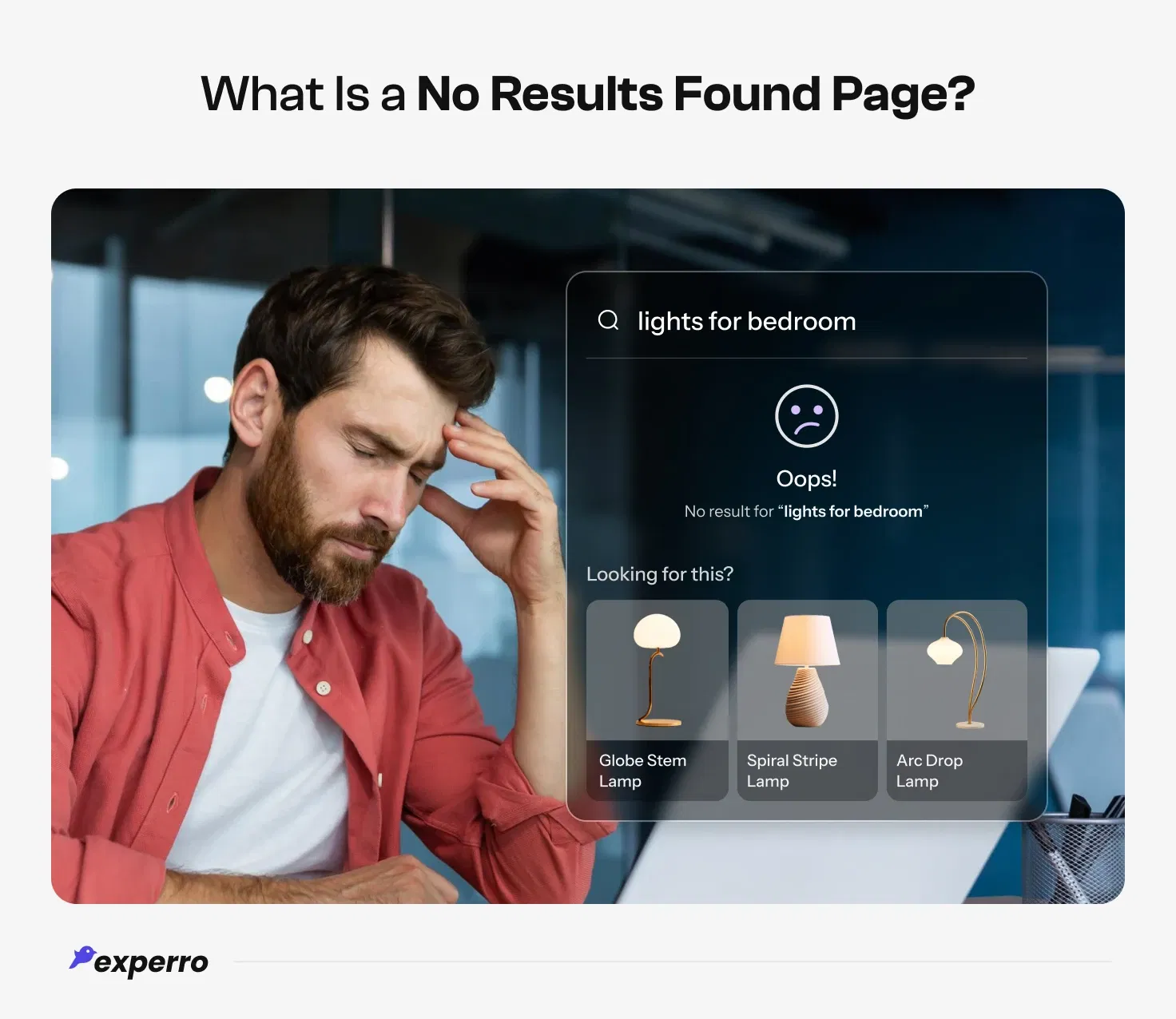core insights box
- A "no results found" page is more than a dead end, it’s a lost conversion.
- Typos, outdated indexing, and strict filters are common triggers for zero results found.
- AI, autocomplete, and smart synonyms can turn zero search results into discovery moments.
- Experro helps you avoid no search results found by personalizing recovery paths and enriching every query.
What’s the best way to recover from a search dead end?
Can a ‘No Results’ page still win you a customer?
A user enters a query into the search bar, hits enter and “no results found” flashes on his screen. What a bummer!
It's not just a blank page; it's a missed opportunity for eCommerce sellers. Such moments don’t just frustrate users; they quietly kill conversions.
Often, it's not that the product doesn’t exist, but that your site simply failed to understand the search.
A "zero results" page shouldn't be a dead end; it should be a gateway to discovery.
To fix the problem, you first need to understand it. And that starts with knowing what a "no results found" page really is.
What Does "No Search Results Found" Mean?

A "no results found" page appears when your website’s product search engine fails to return any matching products, articles, or content based on the user’s query.
You must have seen it - “No results found. Please try a different search.” Or worse, the cold “No results match your search terms”.
These pages are often the result of an empty search result from poor indexing, lack of synonym mapping, or overly strict filters.
- For site visitors, these pages mean disappointment.
- For businesses, they mean lost sales.
Commonly overlooked, no results pages can significantly hurt user trust and site engagement, unless they’re handled smartly.
Let’s uncover what causes these search errors and how to turn them into meaningful engagements.
What Causes “No Search Results Found” Pages?
Multiple factors contribute to "no search results found" issues.

Such as:
- Strict matching logic that doesn’t allow for typos or synonyms.
- Unindexed or outdated content, leading to search error or no results.
- Complex product filters causing 0 results found.
- Lack of AI or NLP-based enhancements.
- Missing support for phrases, custom dictionaries, or autocomplete.
Even the best stores can trigger user frustration by showing “no results found for your search” or “no results found. Please try another search or upload your own design”.
About 50% of eCommerce sites don’t help users recover from a ‘No Results’ page, causing them to leave.
What Happens When Your Search Says ‘Nothing’?
When users see a "no search results" message, it feels like your site has nothing to offer. But in many cases, the issue isn’t the product, it’s how the eCommerce search works.
A mismatch in words, spelling errors, or filters can lead to "zero results found", even when the product exists.
Here’s what goes wrong when the search function offers no next steps to the user:
- Frustration & Exit: Site visitors leave after seeing “we couldn't find any results”.
- Lost Sales: 0 results = 0 conversions.
- Damaged Trust: Repeated “result not found” experiences reduce the brand’s credibility.
- Negative UX: A cold no results found UI or no search results found UX kills engagement.
To avoid these pitfalls, following eCommerce search best practices is crucial to keep users engaged and results relevant.
Want to stop losing users to ‘No Results’ pages? Audit your search experience!
What Are the Strategies to Turn Zero-Results Pages into Opportunities?
Just because results are not found doesn't mean the conversation ends, it’s a chance to guide users, offer support, or suggest alternatives.
Here's how to rebuild it:

1. Show Popular Results with Smart Synonym Matching
Even if the search function fails, don’t leave the user stranded. Display trending or best-selling products with smart synonym mapping so the engine recognizes terms like “jacket” and “coat” as related.
Use a Gen AI-powered search to broaden the result set and avoid messages like “no results were found for your search”.
Zero results handling in eCommerce helps avoid dead ends by showing helpful alternatives. It also reduces common eCommerce issues like bounce rates and drop-offs.
2. Enhance Search with Autocomplete & Suggestions
Incorporate autocomplete to show results as the users type, correcting minor errors. Search autocomplete anticipates intent, helping you avoid ‘search shows no results’ type of situations.
Add “Did you mean…” suggestions to handle typos or confusing queries that might otherwise result in search error, no results, or no data found UI design problems. Even a partial match can guide potential customers toward relevant listings.
3. Suggest Related Content via Dictionaries & Synonyms
When users hit a wall, smart dictionaries and synonym databases can serve up similar content or guides. Instead of “no results found eCommerce”, show product guides, blogs, or educational content based on the intent behind the query.
This supports content discovery even when direct matches fail, minimizing product not found handling risks.
4. Use Snippets & Answers for Exact Phrase Matches
If someone searches using an exact product name or number, phrase match technology and SKU search can help surface quick answers.
Instead of showing “No search results found. Please try again with a different search engine or search query!”, display smart snippets that address the query with precision. This keeps the user engaged and shortens the path to conversion.
5. Enable Faceted Search with Phrase Support
Faceted navigation helps filter results, but too many filters can backfire with “No results found; try different keywords or remove search filters”.
Ensure users can use eCommerce filters easily. Also, support exact phrase recognition so your system understands a query like “blue denim jacket for kids” rather than breaking it apart and returning 0 results.
6. Offer Live Chat or Contact for Help
When all else fails, a “contact us” or live chat option can save the session. Instead of leaving users with “Your search returned no results”; encourage them to reach out.
AI agents can recommend alternative products, check stock availability, or assist with custom queries, reducing cart abandonment due to no more results pages.
7. Redirect Users with Smart Terms & Dictionaries
Use search redirects to guide users from common but non-product terms (like “return policy”) to helpful pages.
This avoids internal site search no results for support-related searches. Build redirects based on custom dictionaries that understand both product language and user behavior.
It prevents the dreaded “no results found for your search query” and helps users find what they actually meant.
After running through the strategies, let's explore how AI and NLP can further minimize or even eliminate zero results altogether.
How AI and NLP Can Prevent Zero Results?
Artificial Intelligence (AI) and Natural Language Processing (NLP) transform the way users interact with search.
They understand user intent beyond specific keywords, recognizing context, spelling errors, slang, and synonyms. This dramatically reduces zero search results scenarios.
AI learns from user behavior and adjusts future suggestions in real-time, avoiding search error or no searches found pitfalls. With an AI-powered natural language search, even vague or complex queries return relevant results, keeping the “no records found” experience at bay.
Experro’s search experience ensures your users always find something relevant!
How Experro Optimizes the ‘No Results’?

Experro helps eliminate frustrating "no search results found" moments through its AI-powered search capabilities built on a flexible headless storefront.
Instead of leaving users at a dead end when their search returns nothing, Experro’s search intelligence enriches queries using features like autocomplete, synonym detection, phrase matching, and NLP.
This ensures to guide shoppers towards relevant AI-powered recommendations, even when their original terms don’t match exactly.
Real-time indexing keeps product data fresh, so nothing is missed due to delays in updates. And if a direct match truly isn’t available, Experro shows popular alternatives or website content snippets to keep users engaged.
By learning from each user’s behavior and preferences, Experro offers personalized recovery paths that turn “no results found for your search criteria” into a chance for discovery, not disappointment.
Never let your customers's search see a dead end again!
Learn more about Experro's reliable search capabilities in the demo...
Conclusion
A "no results found" page doesn’t have to be the end of a user journey, it can be a new beginning. With AI, smart UX, and proactive suggestions, you can turn 0 results into meaningful experiences.
By using features like autocomplete, redirects, and intelligent filtering, you can keep users engaged and shopping, even when exact matches don’t exist.
Stop letting search error no results cost you sales. Schedule a call for a personalized demo on how Experro can eliminate empty search results and boost engagement.
FAQs
What is an example of no search results?
An example would be a user searching for “blue suede boots”, while your store only stocks “navy leather boots”.
In such cases, the system may display “no results found for your search” to the customer. This often happens due to a lack of synonym support or overly specific matching.
A smarter search experience would suggest relevant product alternatives or correct the query automatically.
How to handle no search results in my online store?
To handle no search results, implement features like autocomplete, synonyms, smart redirects, and fallback recommendations.
These tools help avoid empty search result pages and create a user-friendly environment for their engagement. Also, design your no search results found UI to be helpful, displaying popular items, categories, or content instead of a dead-end message.
What is the impact of ‘no search results’ on conversion rates?
High instances of no search results often lead to increased bounce rates, lost sales, and frustrated customers. Each 0 results found moment is a missed opportunity.
Reducing them improves customer retention, session duration, and ultimately, revenue. Even one extra click saved can lead to higher conversions.
What causes users to get no results on search even when the product exists?
Common causes include missing synonyms, outdated or incomplete indexing, rigid filters, or lack of Natural Language Processing (NLP).
This often results in the “Your search did not match” message, even though the item is available under a slightly different name. Ensuring search understands variations and user intent is key.
How does Experro handle 'no search results' differently from default eCommerce search process?
Experro uses AI-powered search, real-time indexing, and contextual query understanding to minimize no results found situations.
It offers dynamic suggestions, content alternatives, and smart redirects. The result is a search experience that adapts to user behavior and always tries to offer a path forward, even when no direct match is found.
How does real-time indexing affect search accuracy?
Real-time indexing ensures that newly added or updated products appear instantly in search results.
This eliminates “no results matching your search” errors caused by stale catalogs. It’s especially critical for fast-moving inventory or seasonal collections.
How can I use Experro to turn ‘no results’ moments into merchandising opportunities?
Experro transforms zero results handling eCommerce into a strategic advantage by showing bestsellers, trending products, or personalized recommendations.
You can also promote related content, collections, or custom messages, turning a potential bounce into an upsell or content discovery moment. It's not just about avoiding a search error but making the most out of it.
Pallavi Dadhich
Content Writer @ ExperroPallavi is an ambitious author recognized for her expertise in crafting compelling content across various domains. Beyond her professional pursuits, Pallavi is deeply passionate about continuous learning, often immersing herself in the latest industry trends. When not weaving words, she dedicates her time to mastering graphic design.
What's Inside
- What Does "No Search Results Found" Mean?
- What Causes “No Search Results Found” Pages?
- What Happens When Your Search Says ‘Nothing’?
- What Are the Strategies to Turn Zero-Results Pages into Opportunities?
- How AI and NLP Can Prevent Zero Results?
- How Experro Optimizes the ‘No Results’?
- Conclusion
Subscribe to Our Newsletters
Get the latest insights delivered straight to your inbox.
